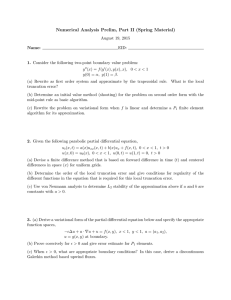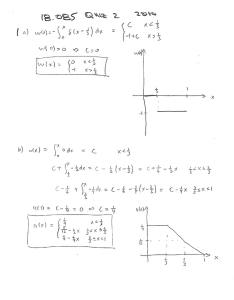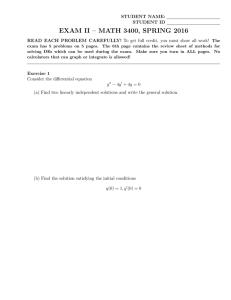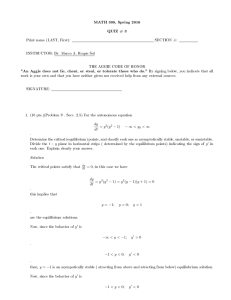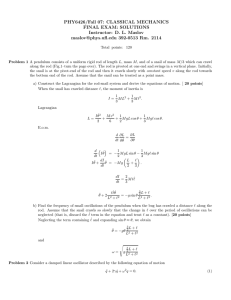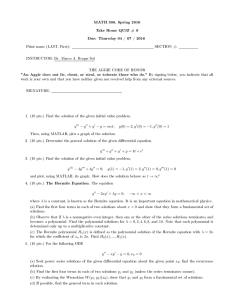1
advertisement
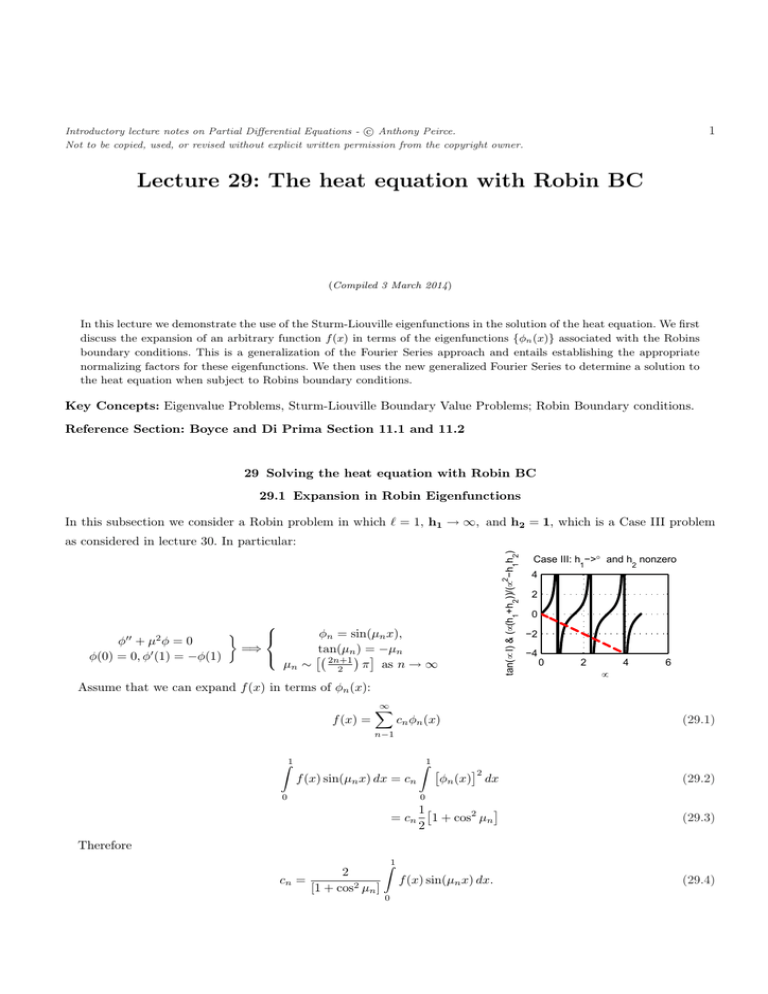
1
c Anthony Peirce.
Introductory lecture notes on Partial Differential Equations - °
Not to be copied, used, or revised without explicit written permission from the copyright owner.
Lecture 29: The heat equation with Robin BC
(Compiled 3 March 2014)
In this lecture we demonstrate the use of the Sturm-Liouville eigenfunctions in the solution of the heat equation. We first
discuss the expansion of an arbitrary function f (x) in terms of the eigenfunctions {φn (x)} associated with the Robins
boundary conditions. This is a generalization of the Fourier Series approach and entails establishing the appropriate
normalizing factors for these eigenfunctions. We then uses the new generalized Fourier Series to determine a solution to
the heat equation when subject to Robins boundary conditions.
Key Concepts: Eigenvalue Problems, Sturm-Liouville Boundary Value Problems; Robin Boundary conditions.
Reference Section: Boyce and Di Prima Section 11.1 and 11.2
29 Solving the heat equation with Robin BC
29.1 Expansion in Robin Eigenfunctions
In this subsection we consider a Robin problem in which ` = 1, h1 → ∞, and h2 = 1, which is a Case III problem
2
tan(µ l) & (µ(h1+h2))/(µ −h1h2)
as considered in lecture 30. In particular:
φ00 + µ2 φ = 0
φ(0) = 0, φ0 (1) = −φ(1)
¾
=⇒
φn = sin(µn x),
tan(µ
n¢) =
£¡
¤ −µn
µn ∼ 2n+1
π
as n → ∞
2
Case III: h1−>∞ and h2 nonzero
4
2
0
−2
−4
0
2
4
6
µ
Assume that we can expand f (x) in terms of φn (x):
f (x) =
∞
X
cn φn (x)
(29.1)
n−1
Z1
Z1
£
¤2
φn (x) dx
(29.2)
¤
1£
= cn 1 + cos2 µn
2
(29.3)
f (x) sin(µn x) dx = cn
0
0
Therefore
2
cn =
[1 + cos2 µn ]
Z1
f (x) sin(µn x) dx.
0
(29.4)
2
If f (x) = x then
R1
x sin(µn x) dx
=
0
=
but − µn cos µn = sin µn
=
¯1
R1
¯
n x)
− cos(µ
− x¯ + µ1n cos µn x dx
µn
0
¯1 0
cos(µn )
sin µn x ¯
− µn + µ2 ¯
n
0
sin µn −µn cos µn
µ2n
(29.5)
= 2 sinµ2µn .
n
Therefore
cn =
4 sin µn
cos2 µn ]
(29.6)
µ2n [1 +
∞
X
f (x) = 4
sin µn sin(µn x)
2 [1 + cos2 µ ]
µ
n
n=1 n
(29.7)
29.2 Solving the Heat Equation with Robin BC
(b) Solution profiles u(x, t) at various times
Figure 1. Left: Initial and boundary conditions; Right:Solution profiles u(x, t)
ut = α2 uxx
u(0, t) = 1
0<x<1
(29.8)
ux (1, t) + u(1, t) = 0
(29.9)
u(x, 0) = f (x).
(29.10)
Look for a steady state solution v(x)
v 00 (x) = 0
v(0) = 1 v 0 (1) + v(1) = 0
v = Ax + B
v(0) = B = 1
¾
v 0 (x) = A v 0 (1) + v(1) = A + (A + 1) = 0
A = −1/2
(29.11)
(29.12)
Sturm-Liouville Two-Point Boundary Value problems
3
Therefore
v(x) = 1 − x/2.
(29.13)
Now let u(x, t) = v(x) + w(x, t)
00
ut = wt = α2 (v%
+wxx ) ⇒ wt = α2 wxx
1 = u(0, t) = v(0) + w(0, t) = 1 + w(0, t) ⇒ w(0, t) = 0
0 = ux (1, t) + u(1, t) = {v 0 (1)+
% v(1)}
f (x) = u(x, 0) = v(x) + w(x, 0)
+wx (1, t) + w(1, t) ⇒
⇒
wx (1, t) + w(1, t) = 0
w(x, 0) = f (x) − v(x).
Let
w(x, t) = X(x)T (t)
(29.14)
00
Ṫ (t)
X
=
= −µ2
2
α T (t)
X
T (t) = ce−α
X 00 + µ2 X = 0
X(0) = 0 X 0 (1) + X(1) = 0
¾
2
µ2 t
The µn are solutions of the transcendental
equation: tan µn = −µn .
Xn (x) = sin(µn x)
∞
X
2 2
w(x, t) =
cn e−α µn t sin(µn x)
(29.15)
(29.16)
(29.17)
(29.18)
(29.19)
n=1
where
f (x) − v(x) = w(x, 0) =
∞
X
cn sin(µn x)
(29.20)
n=1
2
⇒ cn =
[1 + cos2 µn ]
Z1
[f (x) − v(x)] sin(µn x) dx
(29.21)
0
∞
u(x, t) = 1 −
2 2
x X
+
cn e−α µn t sin(µn x).
2 n=1
(29.22)
